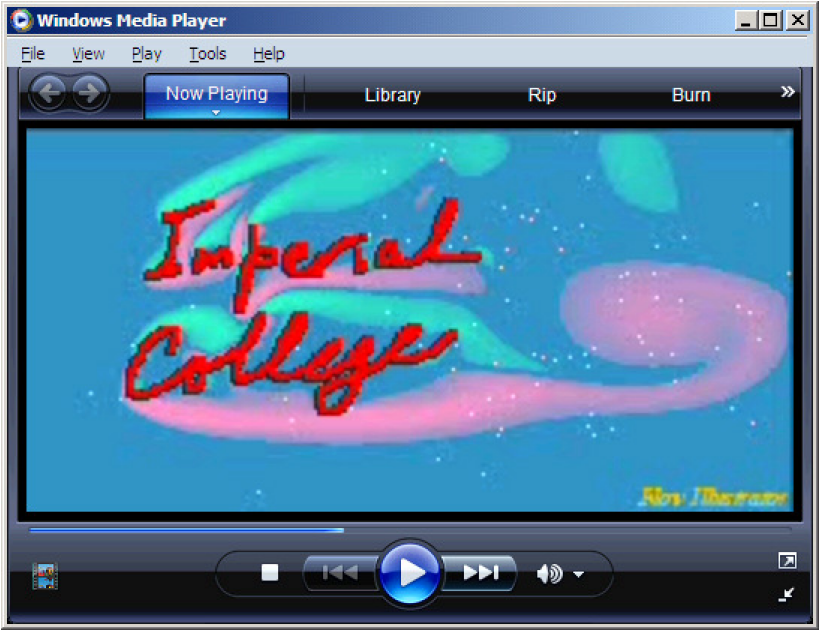Theoretical Fluid Mechanics
Images as the input format for a Navier-Stokes solver
Flow Illustrator
Navier-Stokes solvers are complicated programs. Using them properly requires knowledge and skills. Also, the user has to prepare the input to the solver, that is, first and foremost, the geometry of the boundaries of the flow. In many cases this task is done using additional specialised software.
What, however, if all one wants is just a movie of the flow, and all one has as an input is the picture of the body, the flow past which needs to be visualised? Flow Illustrator is the answer to this. Its first version, an online server, allows the user to upload the picture, adjust a few parameters if desired, and receive a movie of the flow past it. Figures 1, 2, and 3 illustrate the sequence.
![[Picture of a graphic editor with Imperial College handwritten in it]](./images/FIimages/PaintFI.png)
Fig.1. Draw a picture in Paint and save it.
Fig.2. Click on the figure, which is a link to the Flow Illustrator server. Proceed to "Try it" section. Upload your file, adjust parameters, and run the calculation.

Fig.3. Once ready, download the movie and watch it.
This project is a mixture of entertainment, education, public engagement, and research into human-computer interaction.
. For teaching purposes a stand-alone version, an Interactive Flow Illustrator, was developed in 2011-2012
under the Imperial College London Faculty of Engineering-Enabled
Project Interactive Flow Illustrator
(Principal Investigators Profs.S.Chernyshenko and S. Eisenbach).
![[Picture of a Movie Player playing an animation of a flows past the words Imperial College]](./images/FIimages/MovieSnapshot.png)
Fig.4. Interactive Flow Illustrator.
Interactive Flow Illustrator works on the computer of the user and shows the flow visualisation in real time on the screen rather than recording a movie. The Reynolds number and the movie speed can be adjusted on the go. Attempts were also made of using a video camera as a source of the input image in real time. In the future the technology of using images as the input format might find other applications.
Further information:

Try it, it is easy and it is fun!
Timeline:
- Will be in Lille 11-12 December 2025. On 12th, will give a talk at LMFL Fluid Mechanics Webinar (Note the non-standard time, 2pm!).
- Attended and gave a plenary talk at FMFP 2024, Aligarh (U.P), India, 20-23 December 2024.
- Attended the
Oberwolfach Workshop 2431 - Polynomial Optimization for Nonlinear Dynamics: Theory, Algorithms, and Applications
at the Mathematisches Forschungsinstitut Oberwolfach, Germany 28 July - 2 August 2024. - Gave a talk on
Studying fluid flows with auxiliary functions and LMIs
at the IFAC World Congress, held in Yokohama, Japan on 8-14th July 2023. -
Gave a talk on
Bounding time averages: a road to solving the problem of turbulence
at Institut de Mathématiques de Bordeaux, Bordeaux, May 4, 2023. - Gave a talk on QSQH theory of scale interaction in near-wall turbulence: the essence, evolution, and the current state at Institut Pprime, Bordeaux on May 3, 2023.
- Talk at Department of Engineering, University of Cambridge, 4 November 2022, as part of the CUED Fluids seminar series, video: "Accelerating time averaging by adding a Lie derivative of an auxiliary function". Joint work with Owen Tutty and Hanying Yang.
- On August 15, 2022, gave (online) an invited talk "On the path to solving the problem of turbulence" at the International Symposium on Turbulence in Memory of Chou Pei-Yuan's 120th anniversary of birth (IST2022).
- On July 22, 2022, gave (online) a talk "Bounds for time averages: towards solving the problem of turbulence" at the Harbin Institute of Technology Fluid Mechanics Seminar.
- In January-April 2022 was a long-term participant of the Isaac Newton Institute Programme "Mathematical aspects of turbulence: where do we stand?". Gave two talks:
Bounding time averages
andHow quasi-steady is the modulation of near-wall turbulence by large-scale structures?
(with Yunjiu Yang). -
Gave a talk
Auxiliary functionals: a path to solving the problem of turbulence
at The Seminar in the Analysis and Methods of PDE (SIAM PDE) on March 4, 2021. Links to the abstract and the video. - Gave a talk on Extension of QSQH theory to all velocity components, abstract and video, at IPAM, Wednesday, January 13, 2021, as part of the workshop on Transport and Mixing in Complex and Turbulent Flows. Great talks, all recorded, highly recommended.
-
Gave a talk
Accelerating time averaging
at 73rd Annual Meeting of the APS Division of Fluid Dynamics, November 22, 2020: abstract and video. - 2020: the virus ... living online ... most of the year working on additional administration and teaching related to the pandemic ...
- Gave a talk at SIAM Conference on Applications of Dynamical Systems (DS19), , Snowbird, Utah, U.S, May 19 - 23, 2019.
- Gave a keynote lecture at the workshop Scientific Computing Across Scales: Extreme Events and Criticality in Fluid Mechanics, The Fields Institute, Toronto, April 15-18, 2019.
- Gave a talk at European Drag Reduction and Flow Control Meeting 26-29 March 2019, Haus der Kirche, Bad Herrenalb, Germany.
-
Gave a seminar talk on
Accelerating time averaging using auxiliary functions
at the Aerodynamics and Flight Mechanics group seminar, University of Southampton, on 6 February 2019 - Visited the Peking University State Key Laboratory for Turbulence and Complex System in September 13-30, 2018.
-
Attended EeroMech Colloquim 598
Coherent structures in wall-bounded turbulence: new directions in a classic problem
, London, August 29-31, 2018, with a talkLarge-scale motions for the QSQH theory
(with Chi Zhang). -
Gave a talk on
Questions concerning quasi-steady mechanism of the Reynolds number, pressure gradient, and geometry effect on drag reduction
at the Workshop on Active Drag Reduction, Aachen, Germany, 15-16 March 2018. - Gave a lecture course
The problem of turbulence: bounding solutions to equations of fluid mechanics & other dynamical systems
, with Giovanni Fantuzzi providing exercise sessions, at The 6th Bremen Winter SchoolDynamical systems and turbulence
, March 12-16, 2018.
Sergei Chernyshenko